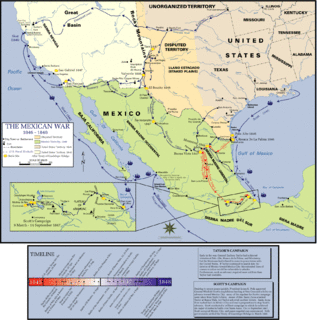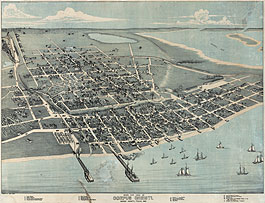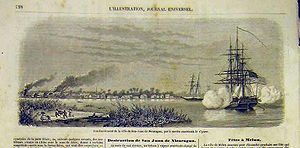
The Battle of Monterey, at Monterey, California, occurred on 7 July 1846, during the Mexican–American War. The United States captured the town unopposed.

In the 18th century and most of the 19th, a sloop-of-war in the Royal Navy was a warship with a single gun deck that carried up to eighteen guns. The rating system covered all vessels with 20 guns and above; thus, the term sloop-of-war encompassed all the unrated combat vessels, including the very small gun-brigs and cutters. In technical terms, even the more specialised bomb vessels and fireships were classed as sloops-of-war, and in practice these were employed in the sloop role when not carrying out their specialised functions.

The first USS Argus, originally named USS Merrimack, was a brig in the United States Navy commissioned in 1803. She enforced the Embargo Act of 1807 and fought in the First Barbary War – taking part in the blockade of Tripoli and the capture of Derna – and the War of 1812. During the latter conflict, she had been audaciously raiding British merchant shipping in British home waters for a month, when the heavier British Cruizer-class brig-sloopHMS Pelican intercepted her. After a sharp fight during which Argus's captain, Master Commandant William Henry Allen, was mortally wounded, Argus surrendered when the crew of Pelican were about to board.
HMS Leander was a 50-gun spar-decked frigate of the Royal Navy which saw service in the Napoleonic Wars, the War of 1812, and the Second Barbary War.

William Harwar Parker was an officer in the United States Navy and later in the Confederate States Navy. His autobiography, entitled Recollections of a Naval Officer 1841–1865, provides a unique insight into the United States Navy of the mid-19th century during an era when the Age of Sail was coming to an end and the advent of steam power and ironclads was beginning.
The first USS Levant was a second-class sloop-of-war in the United States Navy.

The Pacific Squadron was part of the United States Navy squadron stationed in the Pacific Ocean in the 19th and early 20th centuries. Initially with no United States ports in the Pacific, they operated out of storeships which provided naval supplies and purchased food and obtained water from local ports of call in the Hawaiian Islands and towns on the Pacific Coast. Throughout the history of the Pacific Squadron, American ships fought against several enemies. Over one-half of the United States Navy would be sent to join the Pacific Squadron during the Mexican–American War. During the American Civil War, the squadron was reduced in size when its vessels were reassigned to Atlantic duty. When the Civil War was over, the squadron was reinforced again until being disbanded just after the turn of the 20th century.

The second USS Cyane was a sloop-of-war in the United States Navy during the Mexican–American War.

The capture of HMS Cyane and HMS Levant was an action which took place at the end of the Anglo-US portion of the War of 1812. The two British warships HMS Cyane and HMS Levant fought USS Constitution on 20 February 1815, about 100 miles east of Madeira. Following exchanges of broadsides and musket fire, both Cyane and Levant surrendered. The war had actually finished a few days before the action with the ratification of the Treaty of Ghent by both sides, but the combatants were not aware of this.

HMS Cyane was a Royal Navy Banterer-class sixth-rate post ship of nominally 22 guns, built in 1806 at Topsham, near Exeter, England. She was ordered in January 1805 as HMS Columbine but renamed Cyane on 6 December of that year. Cyane had a distinguished career in British service that included the award in 1847 of a clasp to the Naval General Service Medal to any still surviving crew members of either of two actions. On 20 February 1815, she and HMS Levant engaged USS Constitution; outgunned, both had to surrender. She then served as USS Cyane, including a stint on anti-slavery duties, until she was broken up in 1836.

The Pacific Coast Campaign refers to United States naval operations against targets along Mexico's Pacific Coast during the Mexican–American War. It excludes engagements of the California Campaign in areas of The Californias north of the Baja California Peninsula. The objective of the campaign was to secure the Baja Peninsula of Mexico, and to blockade/capture west-coast ports of Mexico—especially Mazatlan, a major port-of-entry for imported supplies. The resistance of Mexican forces to the north in the Los Angeles area and the lack of ships, soldiers and logistical support prevented an early occupation of the peninsula and the west-coast Mexican seaports. The U.S. Navy attempted blockades of the ports three times before being able to successfully blockade and/or occupy them.

The Battle of the Head of Passes was a bloodless naval battle of the American Civil War. It was a naval raid made by the Confederate river defense fleet, also known as the “mosquito fleet” in the local media, on ships of the Union blockade squadron anchored at the Head of Passes. The mosquito fleet deployed three fire rafts, which were ignited and followed the ironclad ram CSS Manassas into the action. The attack occurred after moonset in the early hours of October 12, 1861, and routed the Union fleet, which fled in disorder down the Southwest pass of the delta. After sunrise Commodore George N. Hollins, running low on ammunition and fuel, ordered the mosquito fleet to withdraw upriver.

HMS Levant was a 20-gun Cyrus-class sixth rate of the Royal Navy built by William Courtney, of Chester. She was one of five British warships that USS Constitution captured or destroyed during the War of 1812. She was soon recaptured, and after 1817 was reclassified as a sloop of war. She was broken up in 1820.

The Battle of Corpus Christi was fought between August 12 and August 18, 1862, during the American Civil War. United States Navy forces blockading Texas fought a small land and sea engagement with Confederate forces in and around Corpus Christi Bay and bombarded Corpus Christi. Union forces defeated Confederate States Navy ships operating in the area but were repulsed when they landed on the coast.

CSS Ivy was a sidewheel steamer and privateer purchased by Commodore Lawrence Rousseau for service with the Confederate States Navy, and chosen by Commodore George Hollins for his Mosquito Fleet. The Mosquito Fleet was a group of riverboats converted to gunboats, and used to defend the Mississippi River in the area of New Orleans during the American Civil War.

The Johanna Expedition, or Anjouan Expedition, was a naval operation that occurred in August 1851 during the American anti-slavery patrols off Africa. The event was unrelated to slavery and began after the seizure of the merchant ship Maria and her captain at Johanna Island. The United States Navy sent a sloop-of-war to free the captain, who was still being held, and to demand compensation for the incident. When Sultan Selim refused, the Americans briefly bombarded the island's fortifications.

Captain Robert F. R. Lewis was an officer in the United States Navy. He participated in the Paraguay Expedition, fought in the Mexican War and American Civil War, and served briefly as commander of the Asiatic Squadron.

Libertad, meaning "liberty" in Spanish, was a merchant schooner built on the west coast of Mexico for service between Mexico and the Baja California peninsula and along the coast of Mexico. During the Mexican–American War, she was captured at Loreto, Mexico, along with the schooner Fortuna on 1 October 1846 by the United States Navy sloop-of-war USS Cyane under the command of Commander Samuel Francis Du Pont.

George Nichols Hollins (1799–1878) was an American Captain and Naval Base Commander, in the US Navy and later a Captain and Commodore in the Confederate Navy. He famously won the Battle of the Head of Passes, a naval battle of the American Civil War, returning to New Orleans a hero.

















